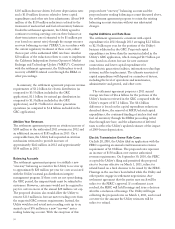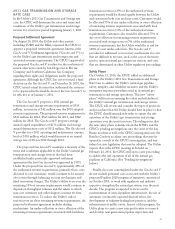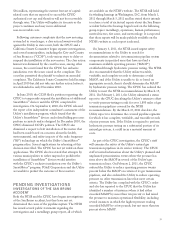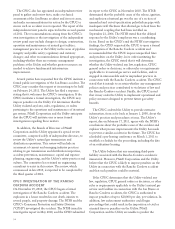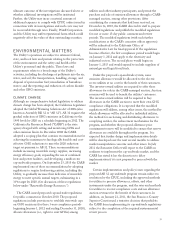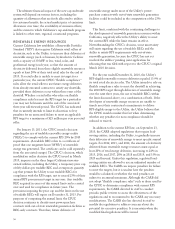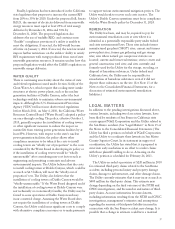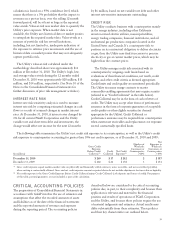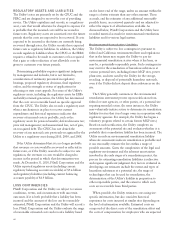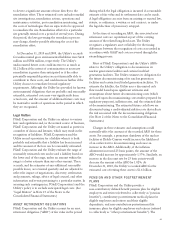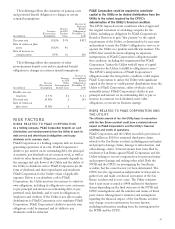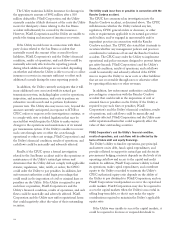PG&E 2010 Annual Report Download - page 44
Download and view the complete annual report
Please find page 44 of the 2010 PG&E annual report below. You can navigate through the pages in the report by either clicking on the pages listed below, or by using the keyword search tool below to find specific information within the annual report.REGULATORY ASSETS AND LIABILITIES
The Utility’s rates are primarily set by the CPUC and the
FERC and are designed to recover the cost of providing
service. The Utility capitalizes and records, as a regulatory
asset, costs that would otherwise be charged to expense if it
is probable that the incurred costs will be recovered in
future rates. Regulatory assets are amortized over the future
periods that the costs are expected to be recovered. If costs
expected to be incurred in the future are currently being
recovered through rates, the Utility records those expected
future costs as regulatory liabilities. In addition, the Utility
records regulatory liabilities when the CPUC or the FERC
requires a refund to be made to customers or has required
that a gain or other reduction of net allowable costs be
given to customers over future periods.
Determining probability requires significant judgment
by management and includes, but is not limited to,
consideration of testimony presented in regulatory
hearings, proposed regulatory decisions, final regulatory
orders, and the strength or status of applications for
rehearing or state court appeals. For some of the Utility’s
regulatory assets, including the regulatory assets for ERBs
and utility retained generation, the Utility has determined
that the costs are recoverable based on specific approval
from the CPUC. The Utility also records a regulatory asset
when a mechanism is in place to recover current
expenditures and historical experience indicates that
recovery of incurred costs is probable, such as the
regulatory assets for pension benefits; deferred income tax;
price risk management; and unamortized loss, net of gain,
on reacquired debt. The CPUC has not denied the
recovery of any material costs previously recognized by the
Utility as a regulatory asset during 2010, 2009, and 2008.
If the Utility determined that it is no longer probable
that revenues or costs would be recovered or reflected in
future rates, or if the Utility ceased to be subject to rate
regulation, the revenues or costs would be charged to
income in the period in which that determination was
made. At December 31, 2010, PG&E Corporation and the
Utility reported regulatory assets (including current
regulatory balancing accounts receivable) of $7.6 billion
and regulatory liabilities (including current balancing
accounts payable) of $4.9 billion.
LOSS CONTINGENCIES
PG&E Corporation and the Utility are subject to various
conditions, events, and circumstances with uncertain
outcomes. If it is both probable that a liability has been
incurred and the amount of the loss can be reasonably
estimated, PG&E Corporation and the Utility will record a
loss. PG&E Corporation and the Utility evaluate the range
of reasonable estimated costs and record a liability based
on the lower end of the range, unless an amount within the
range is a better estimate than any other amount. These
accruals, and the estimates of any additional reasonably
possible losses, are reviewed quarterly and are adjusted to
reflect the impacts of all information available. As
discussed below, PG&E Corporation and the Utility have
recorded material accruals for environmental remediation
liabilities and for various legal matters.
Environmental RemediationLiabilities
The Utility is subject to loss contingencies pursuant to
federal and California environmental laws and regulations
that in the future may require the Utility to pay for
environmental remediation at sites where it has been, or
may be, a potentially responsible party. Such contingencies
may exist for the remediation of hazardous substances at
various potential sites, including former MGP sites, power
plant sites, and sites used by the Utility for the storage,
recycling, or disposal of potentially hazardous materials,
even if the Utility did not deposit those substances on the
site.
The Utility generally commences the environmental
remediation assessment process upon notification from
federal or state agencies, or other parties, of a potential site
requiring remedial action. (In some instances, the Utility
may voluntarily initiate action to determine its remediation
liability for sites that it no longer owns in cooperation with
regulatory agencies. For example, the Utility has begun a
voluntary program related to certain former MGP sites.)
Based on such notification, the Utility completes an
assessment of the potential site and evaluates whether it is
probable that a remediation liability has been incurred. The
Utility records an environmental remediation liability
when site assessments indicate remediation is probable and
it can reasonably estimate the loss within a range of
possible amounts. Given the complexities of the legal and
regulatory environment and the inherent uncertainties
involved in the early stages of a remediation project, the
process for estimating remediation liabilities is subjective
and requires significant judgment. Key factors evaluated in
developing cost estimates include the extent and types of
hazardous substances at a potential site, the range of
technologies that can be used for remediation, the
determination of the Utility’s liability in proportion to
other responsible parties, and the extent to which such
costs are recoverable from third parties.
When possible, the Utility estimates costs using site-
specific information, but also considers historical
experience for costs incurred at similar sites depending on
the level of information available. Estimated costs are
composed of the direct costs of the remediation effort and
the costs of compensation for employees who are expected
40


